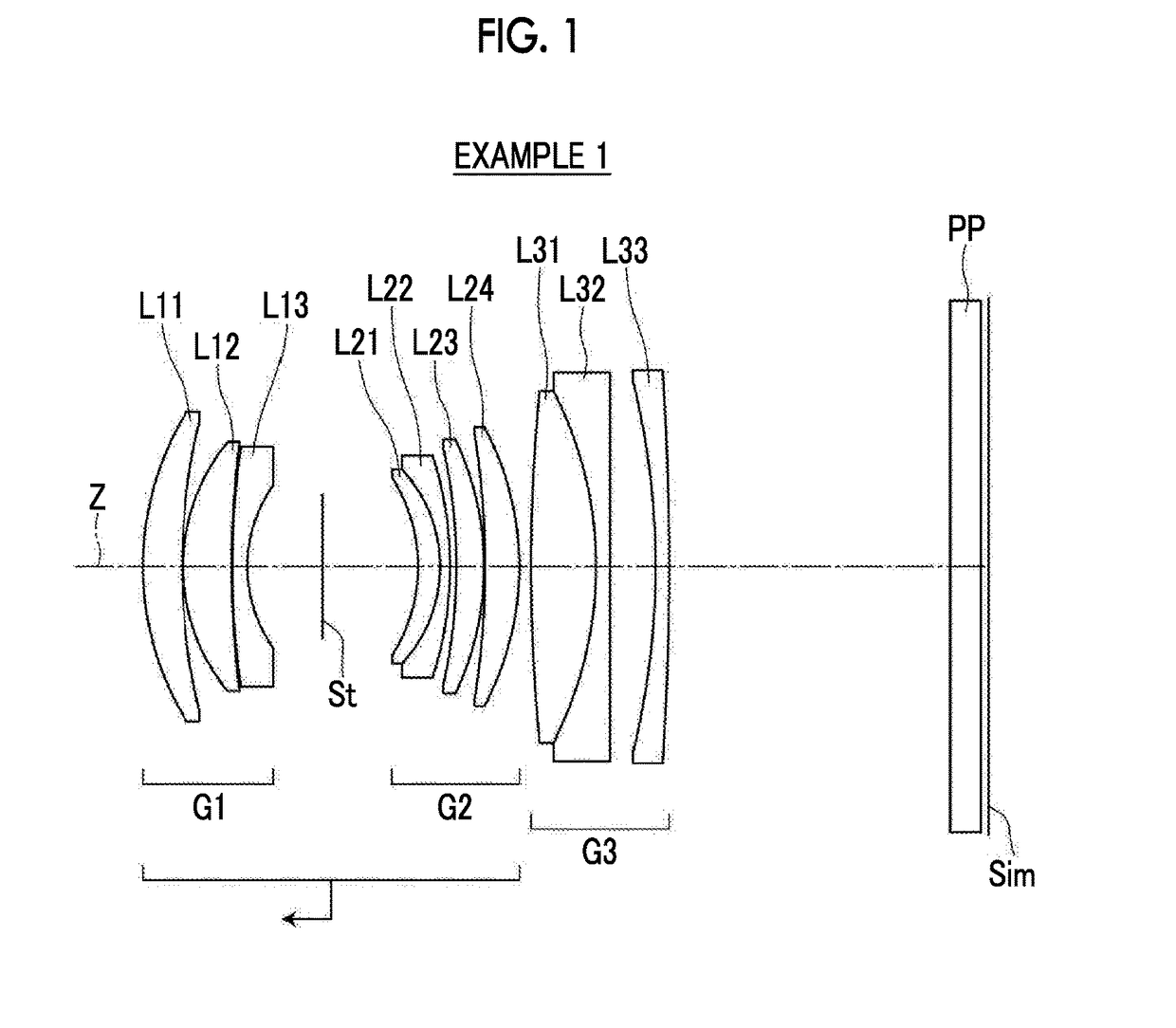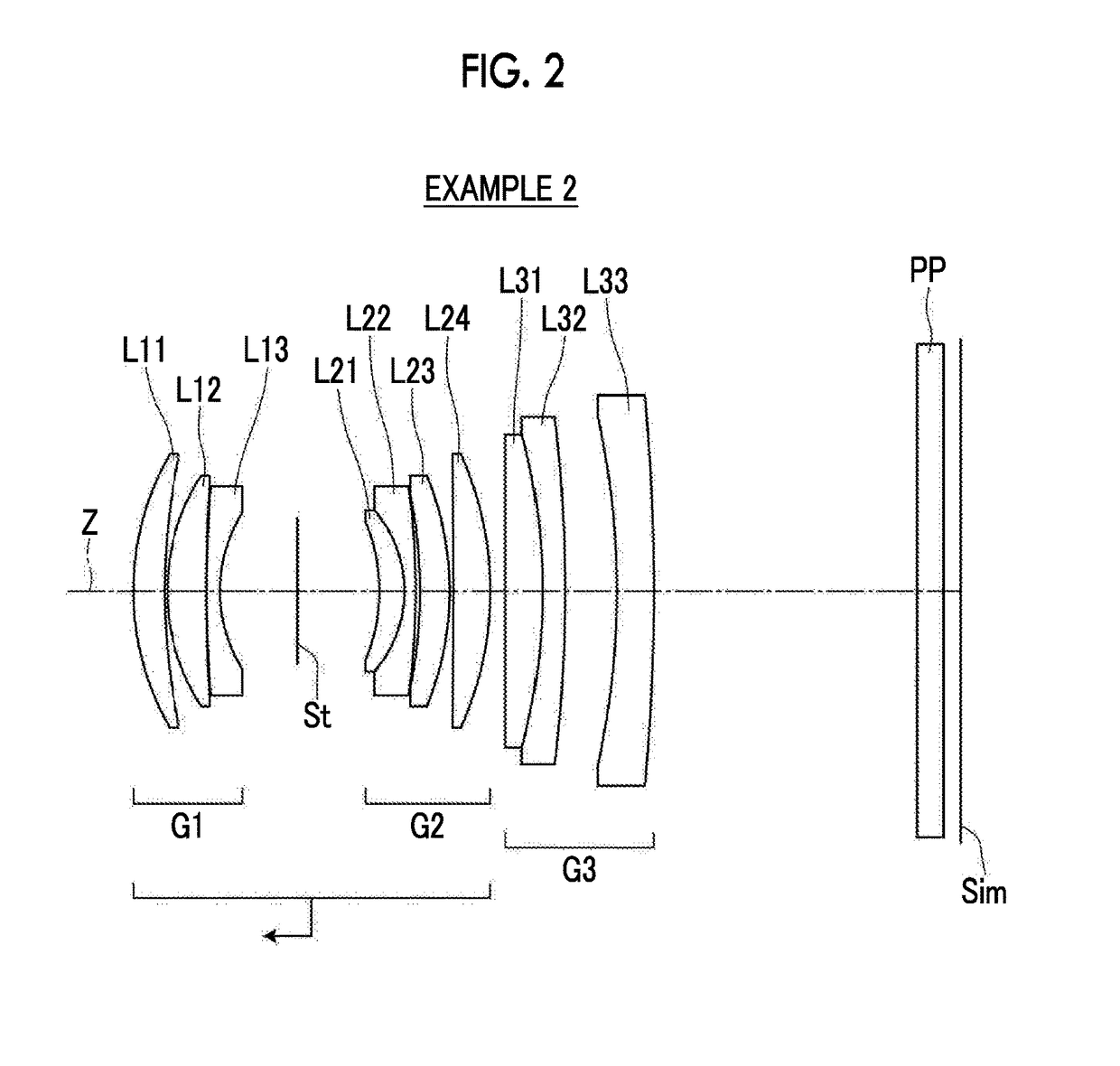Imaging lens and imaging apparatus
a technology of imaging apparatus and lens barrel, which is applied in the field of imaging lens, can solve the problems of insufficiently coping with the recent demands for a decrease in size and a reduction in the ratio of the total length of the lens, an increase in or an increase in the manufacture cost, so as to achieve convenient operation, reduce manufacturing costs, and reduce the size of the lens barrel
- Summary
- Abstract
- Description
- Claims
- Application Information
AI Technical Summary
Benefits of technology
Problems solved by technology
Method used
Image
Examples
example 1
[0091]The cross-sectional view of the imaging lens of Example 1 is shown in FIG. 1, the configuration and the method thereof shown in the drawing is as described above. Thus, repeated description is partially omitted herein. As a group configuration, the imaging lens of Example 1 includes, in order from the object side, three groups, that is, a first lens group G1 that has a positive refractive power, an aperture diaphragm St, a second lens group G2 that has a positive refractive power, and a third lens group G3 that has a positive refractive power group. During focusing from an infinite distance object to a close-range object, the first lens group G1, the aperture diaphragm St, and the second lens group G2 integrally move toward the object side, and the third lens group G3 remains stationary with respect to the image plane Sim. The first lens group G1 includes three lenses, that is, lenses L11 to L13 in order from the object side, the second lens group G2 includes four lenses, that...
example 2
[0098]FIG. 2 is a cross-sectional view of an imaging lens of Example 2. The group configuration of the imaging lens of Example 2 is the same as that of Example 1. The first lens group G1 includes three lenses, that is, lenses L11 to L13 in order from the object side, the second lens group G2 includes four lenses, that is, lenses L21 to L24 in order from the object side, and the third lens group G3 includes three lenses, that is, lenses L31 to L33 in order from the object side. Table 3 shows basic lens data of the imaging lens of Example 2, Table 4 shows specification, and FIG. 10 shows aberration diagrams thereof.
TABLE 3Example 2SiRiDiNdjνdj131.81823.58001.9537532.32272.83690.2900324.37194.49001.5163364.144178.24140.03905147.59141.53001.6989530.13617.14298.81007(St)∞9.29008−20.90762.85001.5928268.629−14.23221.27001.5927035.3110−93.33450.500011−55.84893.36002.0010029.1312−35.32950.420013−959.48774.21001.7432049.3414−38.52001.680015∞4.20001.7291654.6816−71.18662.53001.5927035.3117−167...
example 3
[0099]FIG. 3 is a cross-sectional view of an imaging lens of Example 3. The group configuration of the imaging lens of Example 3 is the same as that of Example 1. The first lens group G1 includes three lenses, that is, lenses L11 to L13 in order from the object side, the second lens group G2 includes four lenses, that is, lenses L21 to L24 in order from the object side, and the third lens group G3 includes three lenses, that is, lenses L31 to L33 in order from the object side. Table 5 shows basic lens data of the imaging lens of Example 3, Table 6 shows specification, and FIG. 11 shows aberration diagrams thereof.
TABLE 5Example 3SiRiDiNdjνdj125.99594.58001.8348142.72267.98100.2000324.41384.31001.5163364.144149.70730.03905140.77950.84001.6398034.47615.882910.16177(St)∞7.50008−18.13942.94001.5928268.629−13.15021.27001.5927035.3110−66.66700.270011−54.19783.76002.0010029.1312−35.04040.420013−180.87734.00001.7432049.3414−38.71831.260015∞3.78001.7291654.6816−105.35462.53001.6889331.071720...
PUM
 Login to View More
Login to View More Abstract
Description
Claims
Application Information
 Login to View More
Login to View More - R&D
- Intellectual Property
- Life Sciences
- Materials
- Tech Scout
- Unparalleled Data Quality
- Higher Quality Content
- 60% Fewer Hallucinations
Browse by: Latest US Patents, China's latest patents, Technical Efficacy Thesaurus, Application Domain, Technology Topic, Popular Technical Reports.
© 2025 PatSnap. All rights reserved.Legal|Privacy policy|Modern Slavery Act Transparency Statement|Sitemap|About US| Contact US: help@patsnap.com



